
Whether you are shipping glass, metal, or plastic bottles, they all have one thing in common, a means of closure. This can come in many different forms, mostly lids or caps designed to prevent inner packaging from leaking while in transit to its destination. The various dangerous goods regulations call for closures to be designed and closed so under normal transport conditions, it is leakproof and secured against loosening. However, if you ship liquids by air, you may come across a term mentioned in IATA 5.0.2.7.2 called “secondary means.” What is a secondary means of closure, and how can I apply it to my inner packaging?
What is a Secondary Means of Closure?
IATA 5.0.2.7.2 states: “For Inner Packaging containing liquids, closures must be held securely, tightly, and effectively by a secondary means. Examples include adhesive tape, friction sleeves, welding or soldering, positive locking wires, locking rings, induction heat seals and child resistant closures. The closure device should be designed so that it is unlikely that it can be incorrectly or incompletely closed. When a secondary means of closure cannot be applied, the inner packaging must be securely closed and placed in a leakproof liner and then placed in the outer packaging.”
Below are a few examples listed at 5.0.2.7.2, the first being a locking ring (known as a Ringlok here at ICC). The Ringlok is designed to provide secondary means of closures for paint cans of all sizes. The primary means of closure would be the lid of the paint can in this case. By snapping the plastic Ringlok over the lid of the paint can in your combination packaging, you fulfill the secondary means of closure requirement per IATA. The Ringlok simply snaps on the top of your paint can and lid using your hands. See the packing instructions here.


The other element here is when you are shipping liquids in an inner container, per IATA 6.3.1.2.7. It states that the inner packagings containing liquids must comply with 5.0.2.9.; which says that the inner packaging must be capable of withstanding a 95KPA pressure differential without leaking for most dangerous goods. Our Ringloks have been pressure tested with our pint, quart, and gallon paint cans. In addition, IATA mentions child proof caps as being a method of secondary means closure. A child-proof cap is essentially two caps, one inside the other. Because there are two caps attached together, this would constitute a primary and secondary closure and fulfills IATA’s requirement. To open these caps, you have to push down on, or sometimes squeeze, the outer cap to engage the inner one. For example, ICC’s one-gallon glass jug below comes with a child-proof cap that has also been pressure tested and fulfills IATAs regulations when shipping liquids.
What if you don’t have a Secondary Means of Closure?
If you are in a scenario where a secondary means of closure listed in IATA 5.0.2.7.2 cannot be applied, you can use a leakproof liner in its place. Essentially, if you have a glass bottle, for example, that does not have a secondary means of closure, and you need to ship a liquid by air, you can use a combination packaging and add a leakproof liner bag as long as your bottle is securely closed. The inner packaging pressure requirements mentioned at 5.0.2.9 would still apply, so you would have to make sure that your bottle/cap combination has been pressure tested or your plastic bag is 95KPA approved. Examples of 95KPA pressure tested bags can be found here.
Here at ICC The Compliance Center, we offer a wide array of IATA compliant packaging. Feel free to call us at 1-888-442-9628 (USA) or 1-888-977-4834 (CAN) for more information.
Stay up to date and sign up for our newsletter!
We have all the products, services and training you need to ensure your staff is properly trained and informed.

|

|

|






 ICC USA
ICC USA ICC Canada
ICC Canada